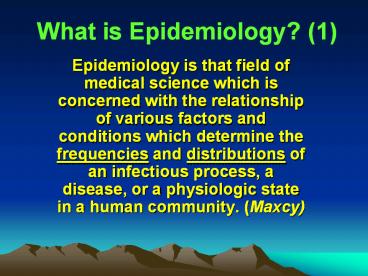What is Epidemiology? (1) - PowerPoint PPT Presentation
Title:
What is Epidemiology? (1)
Description:
Epidemiology is a strategy for the study of factors relating to the etiology, ... Epidemiologists describe disease/states in terms of time, place and person ... – PowerPoint PPT presentation
Number of Views:26
Avg rating:3.0/5.0
Title: What is Epidemiology? (1)
1
What is Epidemiology? (1)
- Epidemiology is that field of medical science
which is concerned with the relationship of
various factors and conditions which determine
the frequencies and distributions of an
infectious process, a disease, or a physiologic
state in a human community. (Maxcy)
2
What is Epidemiology? (2)
- Epidemiology is the study of the distribution
and determinants of health-related states or
events in specified populations, and the
application of this study to control of health
problems. (Last)
3
What is Epidemiology? (3)
- Epidemiology is a strategy for the study of
factors relating to the etiology, prevention, and
control of disease to promote health and to
efficiently allocate efforts and resources for
health promotion, maintenance and medical care in
human populations. - (Detels)
4
- EPI DEMOS LOGOS
- upon people study
- Epidemiology is a philosophy, a strategy, a
methodology, a way of studying a health problem.
Epidemiology is not a body of knowledge.
5
Two Holy Trinities of Epidemiology
- Disease characteristics agent
-
host -
environment - Health is a state of equilibrium between
- Agent Host
- ?
- Environment
6
Two Holy Trinities of Epidemiology (2)
- Disease descriptors Time
- Place
- Person
- Epidemiologists describe disease/states in
terms of time, place and person
7
Ultimate truth denominator
8
- Incidence
- of New Cases Occurring in a Given
- Population in a Specified Time Period_
- Population at Risk in That Time Period
(Speedometer)
9
- Prevalence
- of Cases Existing in a Given
- Population at a Single Point in Time__
- Population at That Time (Odometer)
10
An example of the use of time, place, and person
to describe disease characteristics
- Gathering evidence
- Ordering hypotheses by probability
- Observing place, time (trend), and
- person characteristics
11
(No Transcript)
12
(No Transcript)
13
(No Transcript)
14
(No Transcript)
15
(No Transcript)
16
(No Transcript)
17
(No Transcript)
18
(No Transcript)
19
Reported incidence of disease X 1925-1962, Los
Angeles
20
- Public health is concerned with health of the
public i.e., populations. Epidemiology is the
method/strategy of studying disease/health in
human populations. Epidemiology is therefore the
core science of public health.
21
Uses of Epidemiology (1)
- a. Community diagnosis i.e., what are
- the major health problems occurring
- in a community
- b. Establishing the history of a disease
- in a population e.g., identifying the
- periodicity of an infectious disease
22
Uses of Epidemiology (2)
- c. Describing the natural history of
- disease in the individual e.g., natural
history of HIV infection in the individual
(infection-acute syndrome-asymptomatic
phase-clinical disease-death) - d. Describing the clinical picture of
- disease i.e., who gets the disease,
- who dies from the disease, and what the
outcome of the disease is
23
Uses of Epidemiology (3)
- e. Estimating risk e.g., what factors
- increase the risk of heart disease,
- automobile accidents, and violence
- f. Identifying syndromes and precursors
- e.g., the relationship of high blood
- pressure to stroke, kidney disease, and
- heart disease
- g. Evaluating prevention/intervention
- programs
- h. Investigating epidemics/diseases of
- unknown etiology































